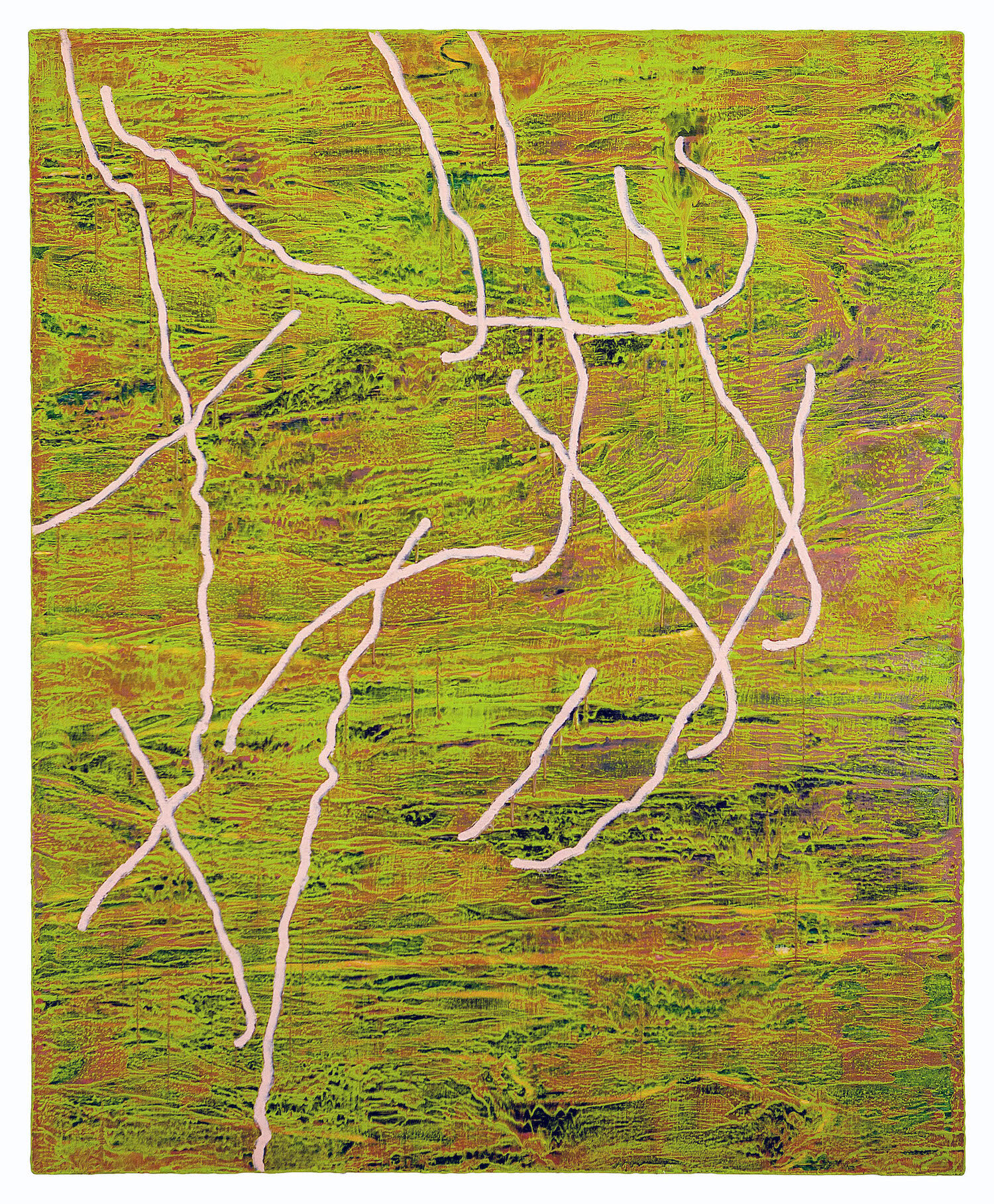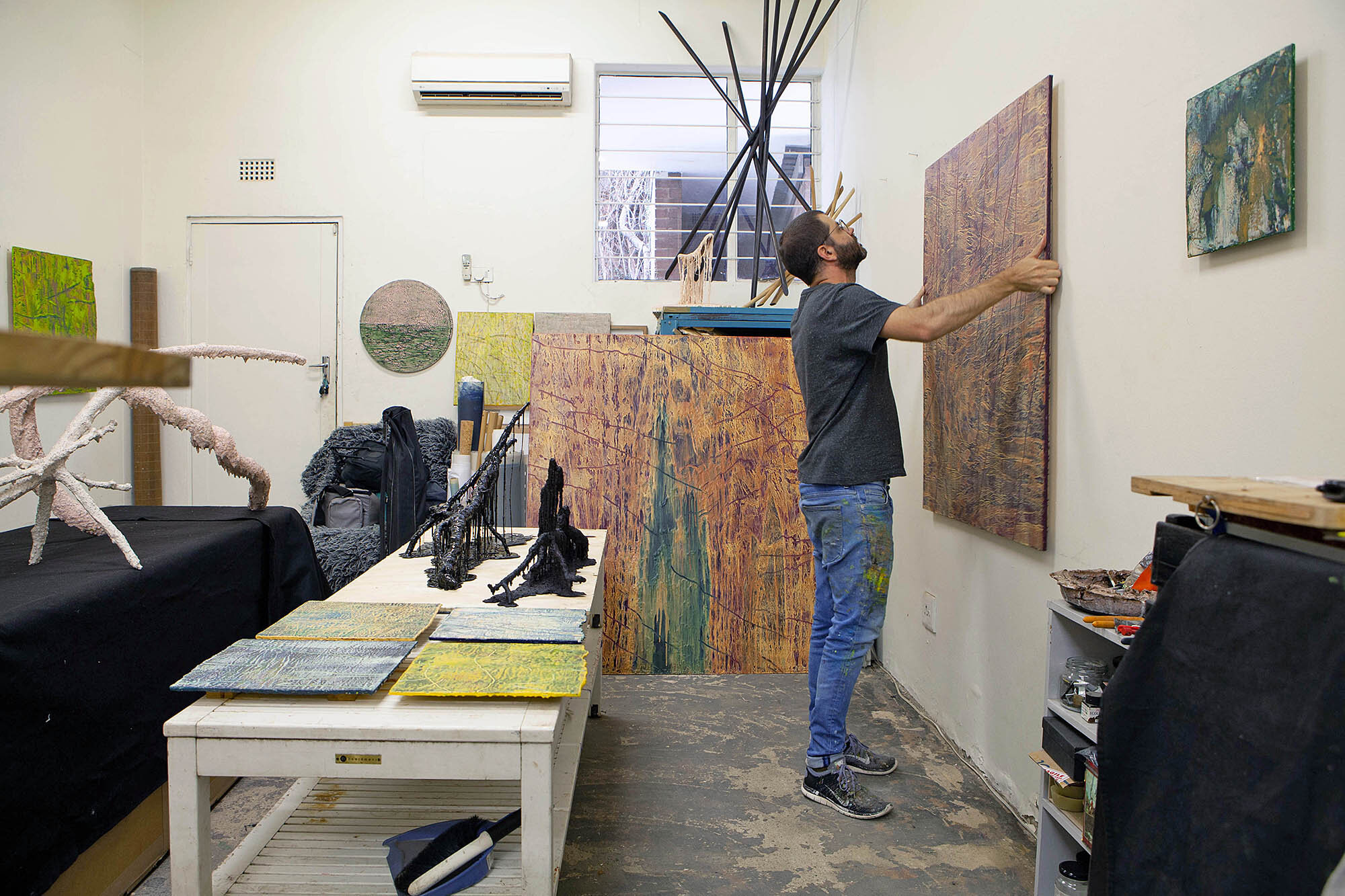Interview with Givan Lotz
Givan Lötz, portait courtsey of Bernard Brand
Tell us who you are and what it is you do?
I am an artist and musician born in 1982 based in Johannesburg.
Tell us a little bit about your background?
I have an information design background that has steadily and deliberately morphed into a fine arts practice over the last 10 years.
Was there a specific moment when you knew that you wanted to be an artist?
While studying design it became increasingly apparent that the design system of working—reacting to a visual communication problem—would not completely satisfy my own curiosity about the world. I have an innate need for creating and making proactively. So ever since my tertiary education, I’ve been actively working towards blurring the lines where now my practice has become almost traditional, at least in medium.
Givan Lötz, Studio View, Johannesburg, 2020
What are themes are most prevalent in your work?
Nature’s prowess and vulnerability — I am drawn to the way paint naturally echoes organic forms, the innate cycles of growth and decay.
Is there any specific artists or movements that influence your work?
Absurdism. Tacit Knowledge.
Givan Lötz, Moth in Mouth, 2020, Encaustic wax on panel, 125 x 100 cm
Has your practice developed over time, if so how?
Yes, my practice used to be based in conceptual, digital and sound mediums. I've spent the last 3 years concentrating on transitioning to painting and sculpture mediums. Not so long ago, my visual projects had an almost didactic approach — it had very clear agendas and goals. It has taken me almost 10 years to push past this naivety to arrive at a visual shorthand that is more about idiosyncratic intuition and uncertainty than clear objective instruction.
Do you have any particular medium or techniques that are unique to your work?
For UNEARTHLY, I focused primarily on using an encaustic painting technique — tempered wax on wood panel. The process is uncommon and normally associated with hobbyists but has a rich and deep history reaching as far back as 5th Century BC in Greece. Most notably, the famed Fayum funeral portraits by Greek painters working in Egypt from 1st century AD have survived precisely because of the preservation properties of wax. I love how physical and immediate the painting process is and that the painting acts almost like a mini-physical world, echoing the processes found in the natural world.
How do you know when an artwork is finished?
While I think it is impossible to plan a good painting, it does help having some conceptual framework or broad goal in mind. When the work satisfies or connects with this idea, then it is ready. I also want to make sure that the work functions from both far away and close-up. I'm searching for intention, immediacy and surface quality as much as good old composition, colour etc.
What tool can't you live without in your studio?
Various heating elements to melt wax.
Givan Lötz, Studio View, Johannesburg, 2020
Why do you make art?
It satisfies my personal curiosity about the world. Unpacking something to understand it better or differently. The act of making or painting is equal parts challenging and joyful.
What is the most memorable response you have had to your work?
Genuine surprise is the most common and welcome response. The works offer something different when experienced in the flesh as opposed to simply viewing it on a screen in the form of a digital catalogue or Instagram post.
Name three artist living or dead that you would like to have dinner with and why?
I'm not as interested in artists as I am in writers of interesting non-genre fiction: David Foster Wallace, Steven Millhauser, Ben Marcus. These writers have a penchant for the uncanny or absurd — finding both horror and humour in our current world.
Givan Lötz, Regret on the Horns, 2020, Assembled branches, acrylic gypsum, granite dust & marble dust, 35 x 85 x 25 cm
Is the artistic life lonely? What do you do to counteract it?
I am very comfortable with solitude. I am highly introverted and work best alone.
What do you dislike about the art world?
The “art world” is a game. Which can be really boring in how typical and predictable people act when they're preoccupied with its constant tedious, fashionable—ultimately futile— petty adjustments.
What role does art play in society?
For me it is about filtering what I experience around and inside me and presenting this as new or different ways of seeing the world. Ultimately others may benefit from the experience as something to dream about or reflect upon — the tension between escape and awareness.
What is your dream project?
A permanent site specific work—a large room/cave/structure perhaps—that is a whole world unto itself, imbued with my particular material aesthetic as a catalogue of a fictional lost place. This as opposed to the regular gallery setting that mostly aims to simply showcase and sell discrete works.
Givan Lötz, Studio View, Johannesburg, 2020
What is the best life lesson being an artist has taught you?
Trust yourself. Trust your intuition.
What’s the best piece of advice you've been given?
Never lose your sense of humour.
What do you do when you experience an artistic block?
I read or go back to drawing without trying to plan or judge too much. It also helps to experiment with a new medium. Do not go onto the internet or Instagram—this is the opposite of inspiration—anything you see there has already been done a thousand times over.
What is the most challenging thing about being an artist?
Balancing making work with the administrative or commercial aspect in order to sustain the practice from year to year.






